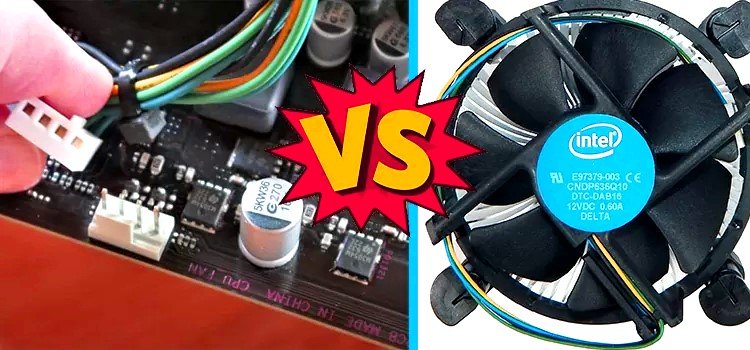When attempting to navigate the motherboard in order to connect the CPU cooler, you will encounter numerous fan terminals that resemble one another. Although the printed identifiers may assist in locating the motherboard, they lack precise descriptive qualities. To illustrate, what are the differences between CPU_FAN vs CPU_OPT?
Use CPU_FAN for Your CPU Cooler
CPU_FAN (also CPUFAN, CPU_FAN1, etc.) is a four-pin fan header located on the motherboard that supplies power to and regulates the CPU cooling. It is typically located above or to the right of the CPU receptacle.
Almost all CPU coolers utilize this universal header, which is present on virtually all motherboards. It functions similarly to any other four-pin fan interface, allowing pulse width modulation (PWM) to regulate the fan speed. The sole distinction lies in its designation as a CPU fan connector, which serves to distinguish it from alternative fan connections. By default, it regulates the speed of the fan in accordance with the temperature of the CPU. Nevertheless, the CPU fan temperature can be modified via the BIOS.
Attach your CPU cooler to the CPU_FAN header if you are constructing a new system or simply experimenting. Although there will be no detrimental consequences if an alternative fan header is utilized (assuming the CPU fan remains operational upon powering on the PC), a notification will appear during system startup informing you that the CPU fan is no longer detected. Connecting two fans to the CPU_FAN header via a Y-splitter may also generate a CPU fan warning.
Obviously, this is not a problem if your CPU fan effectively cools the CPU; you can disable the warning in the BIOS. Nonetheless, connecting the CPU fan to the proper header is simpler than taking additional measures to bypass it.
CPU_OPT indicates an Additional Cooler Fan
The “CPU Optional” CPU_OPT (also CPU_FAN2, etc.) is a four-pin fan header that is typically located on large air conditioners and connects to a secondary CPU fan. CPU_OPT may lack PWM fan control on some low-cost motherboards due to its three-pin configuration. Since the CPU_OPT header is frequently situated adjacent to or below the CPU_FAN header, even seasoned PC architects may inadvertently confuse the two. If you are utilizing an AIO or stock CPU cooler, or if your cooler has a single fan, you may disregard the CPU_OPT header.
Utilize the CPU_OPT header if an aftermarket cooler featuring two fans is present. PWM functionality is identical to that of the “primary” CPU fan, assuming it has four connections; the fan curve for both fans can be utilized to optimize cooling and reduce noise. CPU_OPT, similar to CPU_FAN, adjusts the fan power in response to the CPU temperature.
Similarly to other fan headers, CPU_OPT can be used to increase the number of case fans in order to improve ventilation. As they are interchangeable, either a three-pin or four-pin fan can be connected to the CPU_OPT header. The placement of the header is advantageous if you intend to install a fan atop the case. It will not be a problem to use a Y-splitter on the CPU_OPT header so long as your motherboard can manage the load.
What about SYS_FAN and CHA_FAN?
“CHA_FAN” denotes “chassis fan,” while “SYS_FAN” represents “system fan.” CHA_FAN and SYS_FAN are case fan headers that are not associated with the CPU_FAN and CPU_OPT. They are essentially interchangeable names for the same object. Both three-pin and four-pin connectors are acceptable; the two types are interchangeable. The former is more antiquated, given that PCs historically featured a solitary exhaust fan located at the rear.
Connecting an arbitrary number of case fans is permissible, provided that the motherboard has sufficient headers to accommodate them all. A minimum of one exhaust fan is advised to expel heated air from a computer; the absence of case fans may lead to the computer overheating.
In the end, the manner in which the fans are connected to the motherboard is inconsequential, provided that the CPU fan speed is regulated in accordance with the CPU temperature as specified in the BIOS. Connecting everything “properly” from the beginning will allow you to devote more time to working or enjoying games and less time to tinkering.



